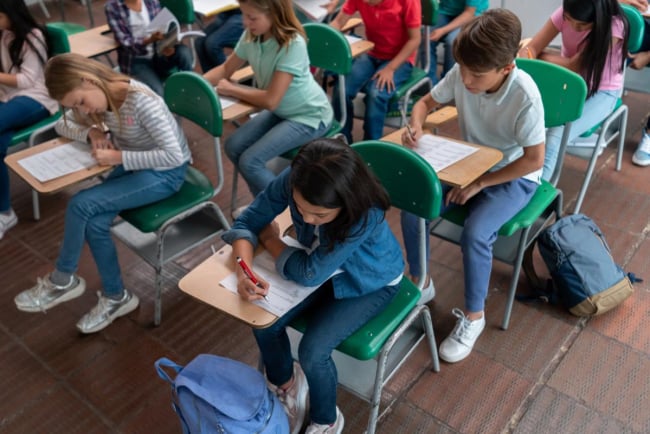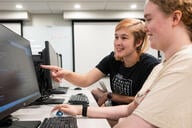You have /5 articles left.
Sign up for a free account or log in.

Hundreds of thousands of students across the country took the NAEP this year; the tests’ results showed declines in both fourth- and eighth-grade math and reading.
andresr/E+/Getty Images
Results of the biennial National Assessment of Educational Progress, which evaluates math and reading skills among fourth and eighth graders, were released Monday, and they were as dismal as many education experts feared. Scores declined sharply in both subjects, and no state showed improvement. It marked the first time in the test’s 53-year history that fourth grade math scores have gone down.
Now educators at all levels are talking about ways to reverse the declines. Higher education leaders have already added supports for college students who suffered pandemic-related learning losses; many now aim to expand their efforts to help K-12 students who will eventually arrive on their campuses potentially with even more ground to make up.
It’s hard to tell yet what these supports will look like, but some anticipate they will involve strengthening the developmental education infrastructure that already exists for underprepared students. Others believe universities must play a role in the interventions currently ongoing at the K-12 level.
The one thing they must avoid, said Richard Arum, a professor of sociology and education at the University of California, Irvine, is the “knee-jerk response” of creating new remedial programs to address learning loss.
“We know from a couple decades now of research and policy that students often end up spinning their wheels in those courses, and they often become a barrier to student success in higher education,” he said.
Alternatives to remedial courses, designed to help underperforming students without forcing them into a long sequence of zero-credit courses, are on the rise, and proponents say that now is an ideal time to grow those programs.
One such model is the corequisite course, in which students are simultaneously placed in a college-level course and a mandatory additional course that provides extra support.
Bruce Vandal, a higher education completion consultant, said that colleges should prepare for the eventual arrival of this year’s underperforming eighth graders by researching the best way to deliver corequisite classes: Should they be taught by the same instructor who teaches the main course, or a different one? And on alternating days, or back to back?
“This, I would say, is an opportunity” to continue improving education for underprepared students, Vandal said. “This is the moment to do it.”
Elizabeth Cox Brand, executive director for the Student Success Center at the Oregon Community College Association, helped start corequisite math programs at 11 Oregon community colleges during the pandemic, and she is convinced that the courses can help students who are far behind in math catch up.
Although Oregon’s community colleges serve more older adult students than recent high school graduates, Brand imagines the corequisite courses would be especially helpful to students who have struggled with remote learning, since they offer hands-on, personal support, which is often hard to achieve in a virtual classroom.
“Overwhelmingly, the faculty were saying it’s not necessarily math content,” she said. “There are other things students need in order to be successful, and a lot of them are nonacademic-type things. They need that sense of belonging.”
They also need to have their basic needs met. While academic support is imperative for accelerating student performance, many higher education leaders believe that a holistic approach—focusing on physical and emotional wellness as well as on learning—is necessary to help struggling students. The approach acknowledges that not all students experience educational disruption in the same way, according to Laurie Fladd, director of holistic student supports for Achieving the Dream, which promotes community college student success.
During the COVID-19 pandemic, for instance, some students struggled to adapt to online learning, while others experienced financial insecurity when a parent lost their job, Fladd said.
“I think the pandemic has certainly exposed and exacerbated inequities that existed already and have been there for many years,” she said. “I think the approaches we’ve taken have always addressed those issues or worked to address those issues.”
Indeed, the NAEP results showed that students with access to more resources—such as high-speed Wi-Fi and a quiet place to work—on average scored better than those with less.
According to Fladd, student needs should be met on a case-by-case basis, so one of the best thing colleges can do to welcome those affected by learning disruptions is to ensure the institution is equipped with the staff and infrastructure to provide individualized support.
“Working with the colleges in our network, we see that supporting students holistically and really taking a commitment to equity … really does help,” she said. “I don’t know if that’s the only response to this, but we know from the colleges that we work with that that’s a very promising practice in helping students be successful.”
Partnering With K-12 Schools
While some experts are focused on supporting students affected by COVID-19-related learning loss once they reach college, others think universities need to partner with their local K-12 schools to improve student outcomes sooner rather than later.
Nikki Edgecombe, senior research scholar at the Community College Research Center, part of Columbia University’s Teachers College, said that virtually every college across the country, from prestigious research institutions to rural community colleges, can do something right now to support its local school system. That might mean providing teachers with professional development, creating curricula or even providing resources to help schools meet their students’ needs for such essentials as food, mental health care and technology.
“You have to talk to the school. I think what we want to ensure is that the supports and resources, the way they’re deployed, work,” Edgecombe said. “The first order of business is to re-establish—and, again, many have been doing this, perhaps even more so in light of the pandemic—but I think we need to establish those open lines of communication.”
Arum, of UC Irvine, also noted that students who scored poorly on NAEP will likely be less inclined to enroll in college at all, making it even more important for institutions to support K-12 systems rather than wait until the students are college-aged to intervene.
“The ones that were most adversely affected are falling off the academic pipeline,” he said.
He proposed that colleges and universities partner with K-12 systems to help improve student performance and increase college access for economically disadvantaged students so that learning loss is the only barrier they have to overcome. Once they are in college, he said, institutions should utilize first-year programs to help them navigate both the academic and socio-emotional landscape of higher education.
While existing infrastructure and partnerships can be useful, Edgecombe implored universities to be creative in how they move forward.
“I worry that if we assume we can just implement existing interventions or practices or policies as we had done before the pandemic, we risk a generation of students—particularly low-income students, particularly students of color—whose long-term economic mobility could be profoundly impacted in negative ways,” Edgecombe said. “I just really hope people do not ignore the significance of what we’re learning from the NAEP scores.”




